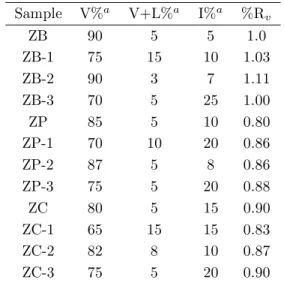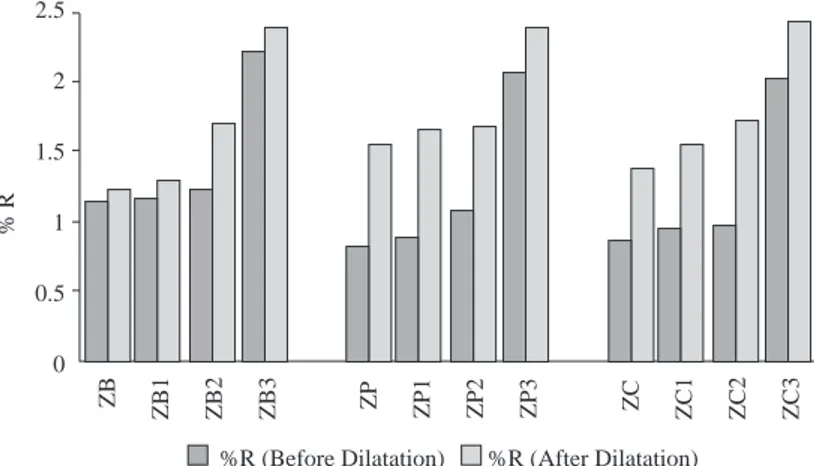c
T ¨UB˙ITAK
Heat Treatment of Maceral Groups Obtained From
Turkish Bituminous Coals
Elif Sultan VAY˙ISO ˘GLU∗& Nevin Gaye ERBATUR
C¸ ukurova University, Chemistry Department,
01330 Adana-TURKEY
Received 01.02.1995
The dilatation properties of parent coals and their maceral fractions were examined. In all the coal samples, the main petrographic constituent was the vitrinite maceral. Reflectance of the vitrinite and inertinite macerals increased after carbonization, while the liptinite maceral disappeared and caused large pores in the vitrinite macerals. All of the coals developed anisotropic coke.
Introduction
The most important area of research in the thermal upgrading of coal and, similarly, of applied coal petrography, is the production of a blast furnace coke which satisfies high standards of strength and constant quality. The possibility of producing a good coke from a given coal depends on its coking power, and several modification techniques have been proposed for achieving better cokes with low-rank coals1−3. The changes
brought about by heat-treatment over temperatures ranging from 25 to 3000◦C are as follows4:
1) 25 - 1000◦C, carbonization
2) 1000 - 1400◦C, semi-graphitization 3) 1400 - 2300◦C, graphitization 4) > 2300◦C, crystallization
Laboratory heating experiments and pilot coke oven experiments have been used extensively in the past to give petrographers a basis for understanding the nature of the reactions of diferent macerals in the coking process4−11. Interaction between coal macerals during carbonization has been widely studied12,13. The development of optical anisotropy during carbonization of bituminous coals from coking-steam coals with a volatile material of greater than 15% dmmf to highly volatile medium coking-coals is well established. Coals of higher rank show only intensification of the reflectance of coal vitrain anisotropy, and coals of lower rank tend to remain isotropic as viewed under the optical microscope.
In the present study, the behavior of a number of Turkish coals and their maceral concentrates against heat treatment was studied. The development of anisotropic cokes from whole coal and maceral concentrates was also studied.
Experimental
Three coal sample of bituminous roal rank were selected from the western Black Sea region of Turkey. The samples were obtained from different seams. They are listed in Table 1 with some analytical data.
Table 1. Analytical data for coals∗
Coal C% H% N% O+S%a V.M Moisture%
ZB 77.3 4.5 0.8 17.4 25.5 0.4
ZP 82.0 5.4 1.3 11.3 35.0 1.3
ZC 73.4 4.8 1.9 19.9 31.3 0.5
a : By difference ∗ : daf
Since the aim of this project was to assess the degree of reactivity of maceral groups towards dilatation, coal samples were separated into density fractions by a float and sink technique using ZnCl2 solutions with
different densities, as decscribed in the literature14. In Table 2, the results of maceral separation are given. The numbers 1, 2 and 3 indicate the lightest, the middle and heaviest maceral fractions, respectively. Tests were carried out with a Ruhrkohle Dilatometer (according to DIN 31739). The heating rate was 3◦C/min. All samples were prepared as relief-free polished particulate blocks. A Leitz MPV-2 orthoplan microscope was used for the reflectance measurements in oil (noil= 1.516 at 24◦C). Bireflectance in oil was taken to be the average of the highest 10 measurements from 50 separate reflectance measurements on each carbonized maceral.
Table 2. Maceral composition of separated fractions
Sample V%a V+L%a I%a %R v ZB 90 5 5 1.0 ZB-1 75 15 10 1.03 ZB-2 90 3 7 1.11 ZB-3 70 5 25 1.00 ZP 85 5 10 0.80 ZP-1 70 10 20 0.86 ZP-2 87 5 8 0.86 ZP-3 75 5 20 0.88 ZC 80 5 15 0.90 ZC-1 65 15 15 0.83 ZC-2 82 8 10 0.87 ZC-3 75 5 20 0.90 a : v/v
Results and Discussion
As seen in Table 2, raw coals contain vitrodetrinite, which is present in higher amounts than liptinite. Because of the petrographical composition, vitrinite is the major maceral group in all separated fractions. In the lightest fraction, Group 1, it was difficult to separate liptinite macerals because liptinites generally lose their identity with increasing rank, making their isolation and identification extremely difficult. When
we examined the heat treatment behaviour of whole coals and the corresponding maceral concentrates, it was interesting to note that medium density fractions of ZB and ZC coals had greater dilatation than whole coal and the other two fractions (Figure 1).
% R 2.5 2 1.5 1 0.5 0 120 100 80 60 40 20 0 % R % D % D ZC ZC1 ZC2 ZC3 ZP ZP1 ZP2 ZP3 ZB ZB1 ZB2 ZB3
Figure 1. Variation in dilatation distribution and reflectance of whole coals and maceral concentrates.
The results of the dilatation test of whole coals and maceral fractions of these coals are summarized in Table 3, where it is seen that they are good coking coals with a characterized coking power of between G5 and G815. All the separated fractions of ZP coal yielded some contraction, while in ZB and ZC coals, only the heaviest maceral fractions yielded contraction. In ZB and ZC coal samples, the percentage of contraction increased with an increasing density of maceral groups; hence, the heaviest fractions gave the highest contraction, greater than that of whole coals and fractions 1 and 2; in spite of this, however, the heaviest fractions did not yield dilatation. Although vitrinite is the major maceral, the amount of inertinite is higher in the heaviest fractions. Hence, even a small amount of inertinite may cause low dilatation since inertinite macerals are characterised by strong cross linkages between aromatics which are difficult to break thermally16. However, the performance of coal in some industrial processes suggests that not all macerals
of the inertinite group are in fact inert but that some contribute to coking and liquefaction17.
Table 3. Heat treatment results of coal and maceral concentrates
Sample Softening Maximum Temp.of max. Maximum Temp. of max.
Temp. (◦C) contraction (%) contraction (◦C) dilatation (%) dilatation (◦C)
ZB 375 26 417 80 458
ZB-1 N.O. N.O. N.O. 60 465
ZB-2 N.O. N.O. N.O. 119 465
ZB-3 389 28 437 30 460 ZP 368 29 410 65 437 ZP-1 400 24 400 40 441 ZP-2 398 25 399 45 436 ZP-3 398 21 428 N.O. N.O. ZP 367 30 418 82 450
ZC-1 N.O. N.O. N.O. 52 440
ZC-2 380 20 404 85 440
ZC-3 378 26 420 N.O. N.O.
Data in the literature indicate that the relationship between reflectance and coking power depends on the maceral composition of the coal15. Liptinite macerals are known to cause dilatation. More dilatation was
achieved from separated fraction 2, which has higher vitrinite concentrate and vitrinite reflectance; therefore, the synergetic effects between macerals of raw coal may be assumed to be responsible for this behaviour.
The increase in the reflectance of the vitrinite cokes can be interpreted in terms of a progressive molecular ordering and increasing molecular size. Measurements taken in polarised light before and after dilatation tests demonstrate that the maximum reflectances increased from 0.86% to 1.25-2.75% in oil after heat treatment. Generally, lower and medium density fractions showed some change in reflectance when heated up to 450◦C while small changes were observed for heavier density fractions (Figure 2). The bireflectance measurements also showed that vitrinite macerals of the coals developed flow-type anisotropic coke. The maximum and minimum reflections of the semi-cokes having anisotropic structures were 1.77%-1.35%, 1.55%,1.24% and 1.15%-0.82% for ZB, ZP and ZC, respectively. Anisotropic development is related to the rank of the coals. Coals of higher rank show only intensification of the reflectance of the coal vitrain anisotropy, and coals of lower rank tend to remain isotropic as viewed under optical microscope. The development of optical anisotropy requires not only planar molecules of appropriate size but also conditions that provide the mobility/fluidity necessary for the ordering of the lamellae. When these two conditions are met, optically anisotropic species develop. The type of species and the extent of their growth depends on the chemical nature of the molecular species present at the onset of anisotropic development and in the maintenance of the appropriate conditions within the carbonising mass18. In this study all coal samples
were from the same region, but of different seams. These results indicate how important the selection of the coals in coke industry is.
ZC ZC1 ZC2 ZC3 ZP ZP1 ZP2 ZP3 ZB ZB1 ZB2 ZB3 % R 2.5 2 1.5 1 0.5 0
%R (Before Dilatation) %R (After Dilatation)
Figure 2. Alteration in reflectance of vitrinites with heat treatment.
The behaviour of sporinite and cutinite depends on their association with other macerals15. In our
samples, liptinite macerals were found together with vitrinites and probably acted as softeners, causing large pores because of fusibility. The transition through a plastic stage is responsible not only for the formation of the pore structures of the coke, but also for its optical character. Microscopic examinations showed that liptinite macerals disappeared, leaving large pores on vitrinites after heat treatment. Vitrinites had higher reflectance, but no differences on inertinite macerals were observed; however, their reflectance was higher than that of untreated material. It is known that inertinite macerals behave as an inert constituent, at least up to 600◦C; hence, our results are in accordance with this observation15. Because of the their densities,
Conclusion
The following conclusions can be drawn from the present study;
1. The reflectance of coke obtained from vitrinite-rich groups is higher than that of raw materials. 2. The heaviest groups gave only contraction while lower and medium density fractions gave only
dilata-tion.
3. The maximum dilatation of vitrinite-rich groups is higher than that of whole coal and the corresponding maceral groups.
4. During heat treatment, liptinite macerals disappeared, leaving large pores on vitrinite macerals, and all coals developed anisotropic coke.
References
1. J. Gibson, ‘Coal and Modern Coal Processing’ (Pitt, G.J. and Millward, G.R., Eds.) Acedemic Press (1979). 2. Y.J. Sunami, Fuel Soc. Japan 58, 958 (1979).
3. H.J. Kimura, Japan Petrol. Inst. (1973). 4. F. Goodarzi, Fuel 63, 820 (1984).
5. F. Goodarzi, Fuel 63, 827 (1984).
6. F. Goodarzi and D.G. Murchison, Fuel 51, 322 (1972). 7. F. Goodarzi and D.G. Murchison, Fuel 57, 273 (1978).
8. M.-Th Mackowsky, ‘4th Int. Conf. on Coal Science’ paper G1, Le Touquet, France (1961). 9. F. Goodarzi and D.G. Murchison, Fuel 56, 89 (1977).
10. F. Goodarzi and D.G. Murchison, Fuel 55, 141 (1976). 11. A. Davis and W. Spackman, Fuel 43, 215 (1964).
12. D.W. Van Krevelen, H.N.W. Dormans and F.J. Huntjens, Fuel 38, 165 (1959). 13. H.R. Brown, A.C. Cook and G.H. Taylor, Fuel 43, 111 (1964).
14. R. Do˘gru and S.l. G¨ok¸cen, Fuel 59, 355 (1980).
15. E. Stach, M.-Th. Mackowsky, M. Teichm¨uller, G.H. Taylor, D. Chadra, R. Teichm¨uller, “Stach’s textbook
of Coal Petrology” Stuttgart (1975).
16. C.F.K. Diessel, Fuel 62, 883 (1983).
17. M. Shibaoka and S. Ueda, Fuel 57, 667 (1978). 18. J.W. Patrick and A. Walker, Fuel 70, 465 (1991).


